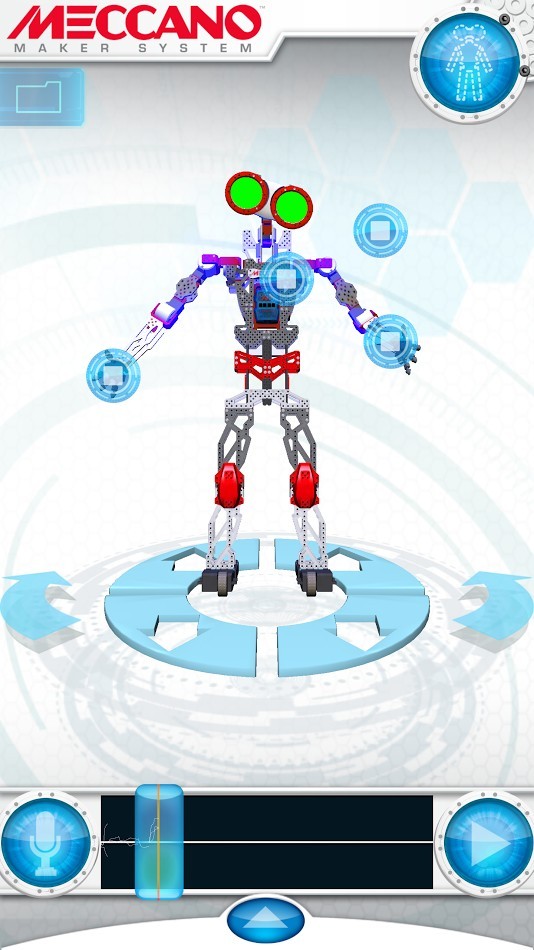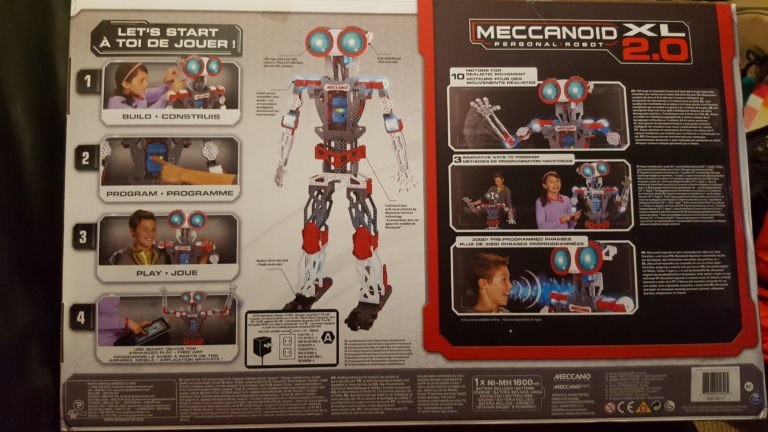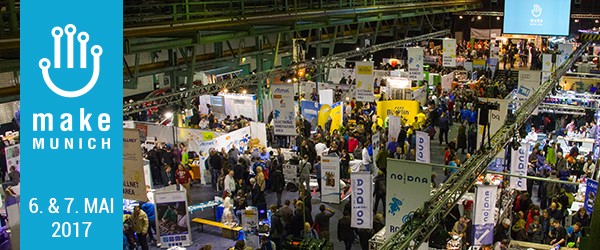RoboCup German Open, Standard Platform League
Sonntag, 7. Mai 2017 – LIVE aus Magdeburg
produziert vom StreamTeam der HTWK Leipzig
https://streamteam.htwk-leipzig.de

RoboCup German Open, Standard Platform League
Sonntag, 7. Mai 2017 – LIVE aus Magdeburg
produziert vom StreamTeam der HTWK Leipzig
https://streamteam.htwk-leipzig.de
RoboCup German Open, Standard Platform League
am Samstag, 6. Mai 2017 – LIVE aus Magdeburg
produziert vom StreamTeam der HTWK Leipzig
https://streamteam.htwk-leipzig.de
produziert vom StreamTeam der HTWK Leipzig
https://streamteam.htwk-leipzig.de
*„Hand of Man“ zerstört Autos mühelos*
„Hand of Man“ – Das Highlight auf der Maker Faire Berlin
*Hannover, 21. April 2017 – Eine acht Meter hohe und sieben Tonnen schwere Handskulptur aus Stahl ist die spektakuläre Attraktion auf der diesjährigen Maker Faire Berlin <https://maker-faire.de/berlin/> am 9. und 10. Juni in der Station am Gleisdreieck. Die hydraulisch betriebene Roboterhand kann Autos mühelos hochheben und in der Luft zerquetschen.*
Der 46-jährige amerikanische *Robotic-Künstler Christian Ristow* entwickelte mit einem kleinen Team innerhalb von vier Monaten die *hydraulisch angetriebene Hand-Skulptur „Hand of Man“*, die schon auf dem Burning Man Festival in Nevada für viel Applaus sorgte.
*„Mir hat es Spaß gemacht, etwas zu bauen, was jedermann intuitiv bewegen kann“,* sagt Ristow. Eine Besonderheit ist die Steuerung. Hierzu gibt es keine Hebel oder Knöpfe, sondern einen Handschuh. Dieser ermöglicht, dass die Bewegung der eigenen Hand von der Roboterhand nachgeahmt wird.
Auf dem bunten DIY-Festival Maker Faire in Berlin *können einige Besucherinnen und Besucher selbst die handschuhartige Steuerung ausprobieren* und mit den Fingern der überdimensionalen Hand ein altes Auto hochheben und zerstören.
Weitere Hingucker auf der Maker Faire Berlin sind erneut die kleinen *Star-Wars-Droiden R2D2*, die der r2-Builder-Club nachgebaut hat, sowie der *RoboCup*, bei dem Schüler und Studenten Nano-Roboter Fußball spielen lassen. Darüber hinaus gehören der selbstgebaute *Fotobus Cliff McLane*, in dem sich die Besucher als Crazy Maker verewigen können, sowie das *Lego-Auto*, das besonders die Kleinen zum Mitbauen einlädt, zu den Highlights.
*Tickets und weitere Informationen* zur Maker Faire gibt es auf der Website: https://maker-faire.de/berlin.
*Noch bis zum 30. April gelten besonders günstige Eintrittspreise. *
Bilderstrecke: http://bit.ly/2oR5SPY
Aachen / München, 20. April 2017 – Am 27. Juni 2017 lädt MathWorks wieder zur MATLAB EXPO in München ein und bietet Experten aus Wirtschaft, Forschung, Industrie und Hochschullehre ein Forum zum Austausch über konkrete Anwendungsbeispiele und Lösungen mit MATLAB und Simulink. Dabei deckt die größte MATLAB & Simulink-Konferenz Anwendungsbereiche von der Automobilbranche über den Maschinenbau bis hin zur Medizintechnik aus nahezu allen Industrien ab und demonstriert darüber hinaus den Einsatz der Produkte in Forschung und Lehre. So haben Anwender die Möglichkeit, über Branchen hinweg Kontakte zu knüpfen, Ideen auszutauschen und sich über Neuerungen der MATLAB- und Simulink-Produktfamilien zu informieren.
Vortragsprogramm und Fachausstellung.
In diesem Jahr stehen vor allem Themen wie Autonome Systeme, Machine Learning, Modellbasierte Entwicklung oder die Modellierung von Maschinen und Anlagen im Vordergrund. Die mehr als 700 Teilnehmer erwartet ein Konferenzprogramm mit 46 Vorträgen in vier parallelen Tracks. Unternehmen wie Bosch, BMW, Volkswagen, Siemens, Infineon oder Trumpf sowie Universitäten aus Deutschland und Österreich sowie Forschungsinstitute berichten über den erfolgreichen Einsatz von MATLAB und Simulink. Auch die begleitende Fachausstellung mit 25 Demo-Points von MathWorks und Partnerunternehmen bietet Experten, Ingenieuren und Managern die Gelegenheit zum persönlichen Austausch und Networking. Darüber hinaus werden Projekte aus dem akademischen Umfeld in einer eigenen Poster-Ausstellung präsentiert.
Keynote Sprecher
Zur Einführung spricht Michelle Hirsch, Head of MATLAB Product Management bei MathWorks, darüber, wie die Technologie autonomer Systeme nicht nur unsere Produkte, sondern auch die Geschäftswelt verändert. In ihrem Vortrag „How to build an Autonomous Anything“ geht sie auf die Voraussetzungen für autonome Systeme – also Systeme mit der Fähigkeit, selbstständiges Handeln erlernen zu können – ein und erläutert, wie Wissenschaftler und Ingenieure diese Elemente zur Entwicklung ihrer autonomen Systeme kombinieren.
Im Anschluss widmet sich Prof. Dr. Sami Haddadin, Direktor des Instituts für Regelungstechnik der Leibniz Universität Hannover, dem Thema „Robots and Humans in the Digital World“. Robotern die direkte physische Interaktion mit dem Menschen zu ermöglichen, war jahrzehntelang eines der primären Ziele der Roboterforschung. In seinem Vortrag wird Prof. Haddadin darstellen, wie die menschzentrierte Roboterentwicklung, -kontrolle und -planung vernetzte Roboter in naher Zukunft für unsere Gesellschaft zu einem Gebrauchsgut machen, und inwieweit die ersten kommerziell verfügbaren, vernetzten Systeme in der Lage sind, zu interagieren.
In seinem Vortrag „Vom Halter-Bieger zum Bit-Schubser“ – Die digitale Herausforderung eines Truck OEM auf dem Weg zum autonomen Fahren“ erläutert Stefan Teuchert, Vice President Electric/Electronic Systems Vehicle Functions, MAN Truck & Bus AG, welchen Einfluss die Trends der Digitalisierung auf das Truck Business haben. Während die Mechanik bisher im Vordergrund des Unternehmens stand, entwickeln sich die Elektronik und Software derzeit zur differenzierenden Disziplin des Unternehmens. Herr Teuchert zeigt, mit welchen Methoden, Tools und Prozessen in einer Hightech-Software-Entwicklung gearbeitet wird und welche Faktoren für den Erfolg ausschlaggebend sind.
Auszug aus dem Konferenzprogramm:
Simulationsbasierte Entwicklung von ADAS und automatisiertem Fahren mittels Machine-Learning
Dr. Andreas Kuhn, Andata
Modellbasierte Entwicklung von Regelungsalgorithmen für Abkantpressen
Dr. Martin Bruckner, Trumpf Austria
Klassifizierung von individuellem Fahrverhalten
Julia Fumbarev, Volkswagen
IRT-Buggy – eine Plattform für autonome Navigation für Forschung und Lehre
Andreas Trzuskowsky, RWTH Aachen
Solar Impulse: Erste erfolgreiche Weltumrundung mit einem Solarflugzeug
Ralph Paul, Solar Impulse
Modellbasierte Systementwicklung für Smarte Sensoren
Dr. Benjamin Schwabe, Infineon
Detaillierte Informationen zur Konferenz finden Sie im Internet unter www.matlabexpo.de.
This article has been automatically translated from German to English
Some weeks ago, I received the Meccanoid XL 2.0 as a review copy. Unfortunately, it was only a few weeks later that I found time to commit myself more closely with this new humanoid robot from Meccano. Even though I got the Meccanoid free of charge, this is a neutral report. Here are my first impressions after the assembly and the first hours of the „programming“.

The Meccanoid XL 2.0 is the successor of Meccanoid G15KS and its smaller G15 version. Even the G15 has received a successor with the Meccanoid 2.0 (excluding XL). The number of parts has been reduced slightly compared to its predecessor, and the previously existing building instructions for a dinosaur are missing on the robot now. There’s a new „Meccasaur“ Dino robot now as a separate product. Also accounted for, is the ability to control the robot through a Smartphone by controlling the movements in front of the camera. This option was apparently completely removed from the app and is also no longer available for the G15 or G15KS. Newly added are over 3000 new gestures and language editions, as well as possibilities of speech recognition. The understood vocabulary of the robot was so significantly expanded compared to the previous version. The Meccanoid XL 2.0 has a size of 1,20 m, what makes him to be really impressive, and an absolute eye-catcher.

The Assembly was largely problem-free; however I must confess at this point that I am a newbie in Meccano. The instructions could have been given in better quality, so it was difficult to identify building steps and the corresponding correct holes for the screws in some places. You should take special consideration on the cable guide, because this is neglected in the building instructions’ manual. Here planning and thinking is required, whereby the degree of difficulty is rather aimed at advanced hobbyists. Even the assembly time of 5-6 hours proves to me that this is not a robot Kit for beginners. The specified minimum age of 10 years here, in my opinion, is somewhat young. Certainly, children need assistance by an adult when reassembling.
The parts are different from what Meccano usually offers, not made of metal but of plastic. Meccano has already received criticism online for the plastic parts, but they did not disturb me. The motors of the robot parts made of iron would be more overworked than with new plastic model.

Unfortunately many of the components are very specialized, creating one’s customized building is complicated. The hope here is that a few days ago on the Meccano Facebook page, there was posted a video, belonging to a new „Meccano mega builds“ series. This series presented alternate building possibilities in combination with other Meccano sets. Also present is a video for a new „Mecca spider“, a robot spider based on the Meccanoid and the 25 in 1 4 x 4 off-roader set. Unfortunately, I have promised instructions in the video not yet on the Meccano site, but I have already informed the support team. Please more of such alternative models are for the meccanoid set!
The Meccanoid can be adjusted to different types of „Programming“. Movement can be recorded by the movement of the limb and play back by the push of a button. This is not of course the correct programming, but it can very quickly store movements, which can then be retrieved. This „programming mode“ is suitable for everyone who shuns the correct programming. Another mode is the recording of motion sequences with the Meccanoid app (for Android and iOS). In the app is a virtual robot available whose movements can be transferred to the real Meccanoid. This method also provides no proper programming, it also only records movements. Correct programming, however, is possible with the „drag and drop – programming“ in the app. Here simple programs can be put together, which is similar to how a flow chart is built. It can be used on events (inputs) such as time, engine movement, button pressure, etc be it responsive and affiliated movements, speech, LED color change and other operations will be launched. Here we can also easily learn how to program operations and programming constructions (loops, conditions). Since the Meccanoid contains no additional sensors, the possibilities here unfortunately are somewhat limited. The app offers an interactive tutorial with an English language edition and German subtitles. Appealing to children here is the ‚Coach Meccanoid‘ virtual robot that gradually step by step guides them on using the app.



Is the Meccanoid good for use in the classroom? No. With a construction period of 5-6 hours, the building period will take too long for teaching. The learning processes through movement of the robot offers no learning effect. The use of the built-in voice control and dialog function (which did not want to work with me in German), is based on volume which is not suitable for a class room. Drag- and -drop programming is certainly suitable for the classroom, unfortunately there is the lack of tasks set or instructions for the teaching of Meccano. The introduction to simple programming sequences can be taught with some adequate preparation. Additional advanced features give hope that the Meccano can provide a download portal for „open source programming“. Here you will find sample projects and libraries to control the meccanoid by third-party hardware.
As far as my impression of the Meccano Meccanoid XL 2.0, should you have questions or suggestions, you would like to use the comment function. Pictures and videos of the set up will be available here soon.

München, den 27.3. 2017. Die Make Munich ist Süddeutschlands größtes Maker- und Do It Yourself Festival, das im kommenden Mai bereits zum vierten mal in München stattfindet und sich inzwischen fest in München etabliert hat.
Am 6./7. Mai 2017 präsentieren dort die Maker ihre Erfindungen, Projekte, Technologien und die neue, inklusive und wissensteilende Maker-Innovationskultur.
An den Messeständen und in vielen inspirierenden Vorträgen wird die Maker-Bewegung in ihrer ganzen Bandbreite erlebbar sein. Aber nur „schauen“ und „zuhören“ ist nicht genug, denn es geht um’s „selber-machen“ und ausprobieren: In zahlreichen Mitmach-Workshops, werden „Nachwuchs-Makern“ alle Fertigkeiten vermittelt, um selbst kreativ und erfinderisch tätig zu werden.
Neben 150 Ausstellern werden mehr als 10.000 technikaffine, umweltbewusste, kreative und innovationsbegeisterte Besucher und Maker aus Deutschland sowie den angrenzenden Ländern Italien, Schweiz und Österreich erwartet.
Zu den Themenklassikern der Makerbewegung wie Elektronik & Internet of Things (IoT), 3D Druck, digitale Tools, Robotik, Maker-Startups und der FabLab/Makerspace Communityarea erwarten sie auf der Make Munich 2017 viele neue Themenbereiche wie Bio-Hacking & Food Maker, Maker & Design, Fashion/Wearables-Technology und Green Maker. In der neuen Quadcopter-Area kann man sich selbst als Drohnen-Pilot versuchen und in der neuen Virtual Reality (VR) + Augmented Reality (AR) Area in virtuelle Welten abtauchen.
Maker sind die kreativen Pioniere, die digitale Werkzeuge wie 3D-Drucker, Lasercutter, Microcontroller u.v.a. nutzen, um innovative Dinge zu erfinden, entwickeln und produzieren. So bleibt Produktion und Produktinnovation nicht mehr nur Unternehmen vorbehalten – das Maker-Movement steht damit für einen Demokratisierungsprozess der Produktion und diese offene, auf Teilen und Gemeinschaft ausgelegte Innovationskultur der Maker, hat das Potential unsere Gesellschaft und Wirtschaft – ähnlich wie es das Internet in den letzten 25 Jahren bereits getan hat – radikal zu verändern. Auf der Make Munich 2017 wird dies sichtbar und unmittelbar erlebbar werden.
Als Festival „von Makern für Maker“ wird die Organisation der Make Munich zum erheblichen Teil aus der Münchener Maker-Community heraus getragen.
Seit 2015 gibt jedoch die neu gegründete Make Germany GmbH der Make Munich als Veranstalter ihren festen geschäftlichen und organisatorischen Rahmen. Die Make Germany GmbH ist ein Social Enterprise, das sich die Förderung und Vernetzung der Maker-Szene auf die Fahnen geschrieben hat.
Make Munich Kurzinfo:
Was: Süddeutschlands größtes Maker- und Do It Yourself Festival
Wann: Sa/So 6.+7. Mai 2017
Offen: 10-18 Uhr
Wo: Zenithhalle, Lilienthallee 29, 80939 München
Eintrittspreise: Kinder bis 12J. kostenlos, Jugendliche 6,-, Erwachsene 15,-, Familien 29,-
http://www.make-munich.de/tickets/

Newark, CA—March 16, 2017—Neato Robotics, leaders in smart robots for the home, today announces an integration with the Google Assistant on Google Home, available across its Botvac Connected series.
“The explosion of artificial intelligence has enabled more sophisticated voice control and we are happy to bring this revolutionary technology to customers. At the heart of Neato’s brand is – and always has been – technology leadership through innovation — the Google Assistant integration further cements our commitment to innovation in the smart home,” said Giacomo Marini, Chairman and CEO of Neato Robotics.
The Google Assistant on your Google Home can answer questions, play music, manage tasks and control devices in your home like Neato connected robot vacuums. When you’re at home you can just say, “Ok Google, tell Neato robot to start cleaning” for a completely hands-free clean. This integration allows customers to check battery level, locate their robot vacuum with the FindMe function, and schedule a cleaning cycle, all through the power of voice. Neato offers the widest range of choices to operate your robot vacuum from anywhere. Customers can choose how to interact with their robot via the Neato App, Amazon Alexa Skill, Neato Chatbot for Facebook, and now, the Google Assistant. This further extends Neato’s vision of SmartLife™ —using technology that integrates seamlessly with your lifestyle to make life simpler and smarter.
Since the release of its first connected robot vacuum, Neato has continued to innovate in the smart connected home. This new integration further expands technical capabilities and ensures that Neato is fully integrated into the smart connected home.
All Neato robots use the company’s patented Neato LaserSmart™ technology that combines laser scanning, continuous room mapping and real time object detection to plan the most efficient course to clean a home. This means the Neato robot alters its navigation instantly when a new obstacle enters its path. It navigates intelligently even in the dark, moves from room to room, and knows when to return to its base for recharging — and then automatically goes back to where it left off to finish the job. The Neato robots’ iconic D-shape design and CornerClever® technology allows it to clean close to walls and deep into corners where dirt and dust often hide. With one of the largest brushes and dirt bins on the market, Neato robots cover more square footage and pick up more debris than other robot vacuums.
Availability
The Google Assistant on Google Home integration is available today in the US. It is supported by all Neato connected robot vacuums including Botvac D3 Connected, Botvac D5 Connected and Botvac Connected. In addition, the Amazon Alexa skill will be available soon in the US, UK and Germany and will be supported by all Neato connected robot vacuums including Botvac D3 Connected, Botvac D5 Connected and Botvac Connected.
About Neato
Neato Robotics designs robots for the home to improve people’s lives, allowing them to spend less time doing household chores and more time on the things they love. Neato drives innovation with intelligent laser navigation, smart home connectivity, and superior cleaning technologies. For more information, visit: www.neatorobotics.com.